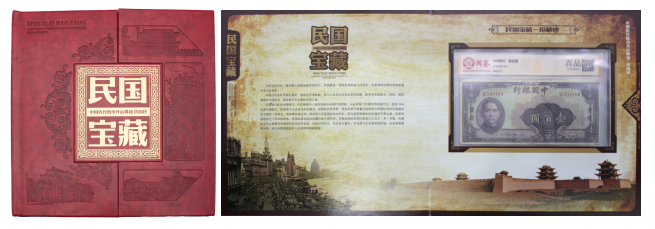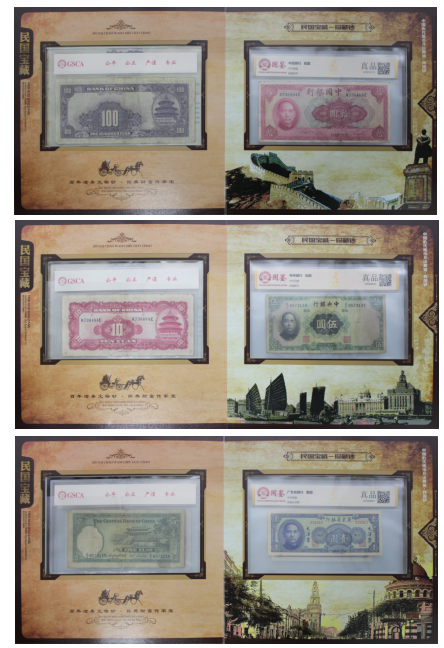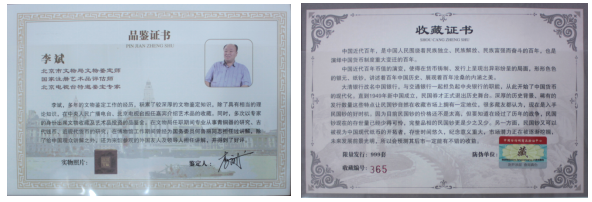Premium Recommendation -The Treasure of the Republic of China – Collected Banknotes

*本次藏品:民国宝藏-珍藏钞(限量发行999套) *
典藏尺寸:尺寸不一
《民国宝藏 – 珍藏钞》从外观上便给人一种庄重且富有历史厚重感的印象。其封面采用了深红色调,这一颜色不仅象征着历史的沉淀,也给人以高贵、典雅之感。封面上有着精致的雕刻纹饰,传统的中式花纹与建筑图案相互映衬,展现出民国时期独特的艺术风格和文化底蕴。
在封面的正中央,“民国宝藏” 四个大字以烫金工艺呈现,字体大气磅礴,凸显出这套珍藏钞的珍贵与独特。其周围装饰有精美的边框花纹,进一步增强了视觉上的美感和庄重感。上方印有 “MIN GUO BAO ZANG” 以及 “中国近代纸币开山鼻祖・民国钞” 的英文和中文说明,点明了这套珍藏钞的核心主题和重要地位。封面四周雕刻的建筑图案,诸如城楼、古建筑等,不仅是对民国时期建筑风貌的一种展现,也从侧面反映了当时的社会文化景观,让收藏者在未翻开珍藏钞之前,便能感受到民国时期的独特氛围。
中国近代百年,是一部波澜壮阔的历史画卷,是中国人民为民族独立、民族解放、民族富强而奋斗的百年,同时也是中国货币制度发生重大变迁的百年。在这一时期,货币的铸制和发行呈现出异彩纷呈的局面,形形色色的银元、纸钞纷纷涌现,它们不仅是经济交易的媒介,更是百年中国历史的见证者,承载着岁月沧桑的内涵之美。
Visually, The Treasure of the Republic of China – Collected Banknotes leaves an impression of solemnity and profound historical weight. Its cover adopts a deep red tone, a color that not only symbolizes the accumulation of history but also conveys a sense of nobility and elegance. The cover is adorned with exquisite carved patterns, where traditional Chinese decorative motifs and architectural designs complement each other, showcasing the unique artistic style and cultural heritage of the Republic of China era (1912-1949).
At the very center of the cover, the four large characters "民国宝藏" (The Treasure of the Republic of China) are presented using a gold stamping technique. The grand and powerful font highlights the rarity and uniqueness of this set of collected banknotes. Surrounding the characters are delicate border patterns, which further enhance the visual aesthetics and sense of solemnity. Above the central characters, the Pinyin "MIN GUO BAO ZANG" and the explanatory text—including the Chinese phrase "中国近代纸币开山鼻祖・民国钞" (The Founding Pioneer of Modern Chinese Paper Money・Banknotes of the Republic of China)—are printed, clarifying the core theme and important status of this collection. The architectural carvings around the cover’s edges, such as city gates and ancient buildings, not only display the architectural style of the Republic of China period but also reflect the social and cultural landscape of that time from a side perspective. Even before opening the collection, collectors can feel the unique atmosphere of the Republic of China era.
The past century of modern Chinese history is a magnificent historical picture scroll. It was a century when the Chinese people struggled for national independence, liberation, and prosperity; at the same time, it was also a century that witnessed significant changes in China’s monetary system. During this period, the minting and issuance of currency presented a diverse and vibrant scene—various types of silver dollars and paper banknotes emerged one after another. These currencies were not only mediums of economic transactions but also witnesses to China’s century-long history, carrying the connotative beauty of the vicissitudes of time.

*本次藏品:民国宝藏-珍藏钞(限量发行999套) *
典藏尺寸:尺寸不一
清朝末年,中国传统的货币体系逐渐瓦解,随着西方列强的入侵和国内经济形势的变化,货币改革势在必行。进入民国后,货币制度经历了多次调整和变革。从北洋政府到南京国民政府,货币发行权逐渐集中,同时也受到国内外政治、经济因素的影响,纸币的种类和样式不断变化。
其中,大清银行改名中国银行,并与交通银行一起担负起中央银行的职能,这一举措开启了中国货币的现代化进程。然而,民国时期政局动荡,战乱频繁,加上通货膨胀等因素,货币的发行和流通面临诸多挑战。但也正是在这样复杂的背景下,民国钞得以诞生并流传,它们记录了那个时代的经济状况、政治格局以及社会风貌,具有极高的历史研究价值。
中国银行壹佰圆纸币
在这套《民国宝藏 – 珍藏钞》中,中国银行发行的壹佰圆纸币十分引人注目。纸币整体设计较为大气,正面印有孙中山先生的肖像,孙中山先生作为中国民主革命的伟大先驱,他的形象出现在纸币上,具有重要的象征意义,代表着民国时期追求民主、独立的精神。
纸币的颜色以灰蓝色调为主,背景装饰有复杂而精美的花纹,这些花纹不仅具有装饰性,也在一定程度上起到了防伪的作用。纸币上方印有 “中国银行” 字样,下方则标明了 “壹佰圆” 的面值以及发行地点 “重庆”。纸币的冠号和编号清晰可见,体现了当时的印刷工艺水平。
中国银行拾圆纸币
中国银行发行的拾圆纸币,采用了较为鲜艳的粉红色调,在视觉上给人一种柔和且亮眼的感觉。正面同样印有孙中山先生的肖像,展现了对孙中山先生的尊崇以及他在民国历史中的重要地位。
纸币的中间位置是标明 “拾圆” 面值的区域,周围环绕着精美的花纹图案,这些图案以传统的中式元素为基础进行设计,具有浓郁的中国风。纸币上方印有 “中国银行” 字样,冠号和编号工整排列在两侧,体现了当时纸币设计的规范性和严谨性。
中央银行伍圆纸币
中央银行发行的伍圆纸币,颜色以浅绿色为主,整体风格简洁而不失庄重。正面印有一位男子的肖像,背景装饰有传统的中式花纹和建筑图案,体现了民国时期纸币设计对传统文化元素的运用。
纸币上方清晰印有 “中央银行” 字样,下方标明 “伍圆” 面值,冠号和编号分别位于纸币的左右两侧。这张纸币见证了中央银行在民国时期货币发行中的重要角色,也反映了当时货币在市场流通中的使用情况。
广东省银行壹圆大洋票
广东省银行发行的壹圆大洋票,采用了蓝紫色调,设计风格具有地方特色。正面印有孙中山先生的肖像,展现了孙中山先生在广东地区乃至全国的深远影响力。
纸币中间标明 “壹圆” 面值,周围环绕着富有岭南风格的花纹图案,体现了地域文化特色。纸币上方印有 “广东省银行” 字样,下方还有 “大洋票” 的说明,表明了这种纸币的特定属性和使用范围。
厦门劝业银行伍角纸币
厦门劝业银行发行的伍角纸币,颜色以蓝灰色调为主,设计相对简约。正面印有银行名称 “厦门劝业银行” 以及 “伍角” 面值,背景图案为一座中式建筑,展现了地方银行的特色和地域文化风貌。
广东省银行壹角纸币
这张广东省银行发行的壹角纸币,整体呈现出一种复古的色调,偏向于淡紫色系。纸币正面中央位置印有孙中山先生的肖像,孙中山先生目光坚毅,展现出其伟大的领袖风范和对国家民族的深切关怀。 肖像周围环绕着精致的花纹装饰,这些花纹具有浓郁的民国时期风格,线条细腻流畅,增添了纸币的艺术美感 。纸币上方清晰地印有 “广东省银行” 的字样,字体工整规范;左右两侧分别标明 “壹角 ” 的面值,字体醒目,便于识别。纸币上还印有冠号等信息,这些字符排列整齐,是纸币身份的重要标识。
广东省银行伍分纸币
这张广东省银行发行的伍分纸币,整体风格古朴而具有时代特色。纸币主色调为淡紫色系,给人一种典雅、复古的视觉感受。
正面中央位置,是孙中山先生的肖像,孙中山先生目光深邃、神情庄重,展现出伟大革命家的风范。作为中华民国的主要缔造者,孙中山先生的形象被印在纸币上,彰显了他在民国时期的崇高地位以及对国家的卓越贡献。在肖像周围,环绕着精致细腻的花纹装饰,这些花纹线条流畅、图案精美,不仅起到了装饰美化的作用,还在一定程度上增加了纸币的防伪功能。纸币上方印有 “广东省银行” 字样,字体工整规范,体现了当时的印刷工艺水平。
面值 “伍分” 字样则多次出现在纸币的左右两侧以及其他显眼位置,字体清晰醒目,方便民众识别。此外,纸币上还印有冠号 “AF” 等字符,这些字符是每张纸币独一无二的标识,有助于追踪纸币的发行和流通信息。
《民国宝藏 – 珍藏钞》限量发行 999 套,这一限量举措极大提升了其收藏价值与稀缺属性。在收藏领域,“物以稀为贵” 是一条重要原则,有限的发行数量使得这套珍藏钞在市场上成为稀缺资源。与大量发行的普通收藏品不同,仅有 999 套的《民国宝藏 – 珍藏钞》 ,意味着每一套都更加珍贵,更具独特性和专属性,满足了收藏爱好者对于珍稀藏品的追求。
同时,限量发行也为这套珍藏钞赋予了特殊的纪念意义。它仿佛是对民国那段波澜壮阔历史的一次精心提炼与浓缩,通过限量的方式,让这一承载着民国货币文化的藏品,成为历史长河中独特的印记,吸引着众多对民国历史、货币收藏感兴趣的人士关注。
这套限量发行的《民国宝藏 – 珍藏钞》内含多张民国时期具有代表性的纸币。 其中涵盖了中国银行、中央银行、广东省银行、厦门劝业银行等不同金融机构发行的纸币,面值丰富多样,从伍分、拾圆到壹佰圆等均有涉及 。
以广东省银行发行的纸币为例,有伍分、壹角、壹圆等不同面值,这些纸币正面多印有孙中山先生的肖像,展现了孙中山先生在民国历史中的重要地位,也反映了当时广东地区的金融风貌。再如中国银行发行的纸币,设计大气精美,有着复杂的花纹装饰和清晰的文字标识,体现了当时较高的印刷工艺水平 。这些不同银行、不同面值的纸币,共同构成了一个较为完整的民国纸币收藏体系,全方位展示了民国时期货币的多样性和独特魅力。
By the late Qing Dynasty (1636-1912), China’s traditional currency system gradually collapsed. With the invasion of Western powers and changes in the domestic economic situation, currency reform became imperative. After the establishment of the Republic of China (1912-1949), the currency system underwent multiple adjustments and transformations. From the Beiyang Government to the Nanjing National Government, the authority to issue currency was gradually centralized. However, influenced by domestic and international political and economic factors, the types and designs of banknotes continued to change.
Among these developments, the Great Qing Bank was renamed the Bank of China, which, together with the Bank of Communications, assumed the functions of a central bank. This initiative marked the beginning of the modernization process of China’s currency. Nevertheless, the Republic of China era was characterized by political instability, frequent wars, and inflation, which posed numerous challenges to the issuance and circulation of currency. It was precisely against this complex backdrop that Republic of China banknotes emerged and circulated. These banknotes recorded the economic conditions, political structure, and social landscape of that era, holding immense value for historical research.
1. Bank of China 100-Yuan Banknote
In the collection The Treasure of the Republic of China – Collected Banknotes, the 100-Yuan banknote issued by the Bank of China stands out prominently. The overall design of the banknote is grand and majestic. On the obverse, there is a portrait of Dr. Sun Yat-sen, the great pioneer of China’s democratic revolution. His image on the banknote carries significant symbolic meaning, representing the spirit of pursuing democracy and independence during the Republic of China period.
The banknote features a predominantly gray-blue color scheme, with intricate and exquisite patterns adorning the background. These patterns not only serve a decorative purpose but also contribute to anti-counterfeiting to a certain extent. The words "Bank of China" are printed at the top of the banknote, while the denomination "100 Yuan" and the issuance location "Chongqing" are marked at the bottom. The prefix and serial number of the banknote are clearly visible, reflecting the printing technology level of the time.
2. Bank of China 10-Yuan Banknote
The 10-Yuan banknote issued by the Bank of China adopts a bright pink color scheme, creating a soft yet striking visual effect. Similar to the 100-Yuan note, the obverse also bears a portrait of Dr. Sun Yat-sen, demonstrating respect for him and highlighting his important position in the history of the Republic of China.
The central area of the banknote indicates the denomination "10 Yuan," surrounded by exquisite decorative patterns. These patterns are designed based on traditional Chinese elements, exuding a strong Chinese style. The phrase "Bank of China" is printed at the top, and the prefixes and serial numbers are neatly arranged on both sides, embodying the standardization and rigor of banknote design during that period.
3. Central Bank of China 5-Yuan Banknote
The 5-Yuan banknote issued by the Central Bank of China features a light green main color, with an overall style that is simple yet solemn. The obverse displays a portrait of a man, and the background is decorated with traditional Chinese patterns and architectural designs—reflecting the integration of traditional cultural elements into banknote design during the Republic of China era.
The words "Central Bank of China" are clearly printed at the top of the banknote, and the denomination "5 Yuan" is marked at the bottom. The prefix and serial number are located on the left and right sides of the banknote, respectively. This banknote is a testament to the Central Bank’s important role in currency issuance during the Republic of China period and also reflects the circulation and usage of currency in the market at that time.
4. Kwangtung Provincial Bank 1-Yuan Silver Dollar Note
The 1-Yuan Silver Dollar Note (Dayang Piao) issued by the Kwangtung Provincial Bank uses a blue-purple color scheme and features a design with distinct local characteristics. The obverse bears a portrait of Dr. Sun Yat-sen, showcasing his profound influence in Guangdong Province and across the country.
The central part of the banknote indicates the denomination "1 Yuan," surrounded by decorative patterns with Lingnan regional style—embodying local cultural traits. The phrase "Kwangtung Provincial Bank" is printed at the top, and the note also includes the description "Dayang Piao" (Silver Dollar Note) at the bottom, specifying the note’s unique nature and scope of use.
5. Amoy Promotion Bank 50-Cent Banknote
The 50-Cent banknote issued by the Amoy Promotion Bank (Xiamen Quanye Bank) has a mainly blue-gray color scheme and a relatively minimalist design. The obverse prints the bank’s name "Amoy Promotion Bank" and the denomination "50 Cents," with a traditional Chinese building as the background pattern—highlighting the characteristics of local banks and regional cultural features.
6. Kwangtung Provincial Bank 10-Cent Banknote
This 10-Cent banknote issued by the Kwangtung Provincial Bank presents a retro color tone, leaning toward a pale purple hue. At the center of the obverse is a portrait of Dr. Sun Yat-sen, whose firm gaze embodies his great leadership and deep concern for the nation and people.
The portrait is surrounded by exquisite decorative patterns, which carry a strong Republic of China-era style with delicate and smooth lines—enhancing the artistic appeal of the banknote. The words "Kwangtung Provincial Bank" are clearly printed at the top in neat and standardized font. The denomination "10 Cents" is marked on both the left and right sides in a bold, eye-catching font for easy identification. The banknote also includes information such as a prefix; these neatly arranged characters serve as an important identifier of the banknote’s identity.
7. Kwangtung Provincial Bank 5-Cent Banknote
This 5-Cent banknote issued by the Kwangtung Provincial Bank has an ancient and era-specific style. Its main color is pale purple, creating an elegant and retro visual experience.
At the center of the obverse is a portrait of Dr. Sun Yat-sen, with deep eyes and a solemn expression that reflects the demeanor of a great revolutionary. As the main founder of the Republic of China, Dr. Sun Yat-sen’s image on the banknote highlights his lofty status and outstanding contributions to the country during the Republic of China period. Surrounding the portrait are exquisite and delicate decorative patterns with smooth lines and beautiful designs—these not only serve to decorate and beautify the banknote but also enhance its anti-counterfeiting function to a certain extent.
The phrase "Kwangtung Provincial Bank" is printed at the top in a neat and standardized font, reflecting the printing technology of the time. The denomination "5 Cents" appears multiple times on the left and right sides of the banknote as well as in other prominent positions, with clear and eye-catching font for easy recognition by the public. In addition, the banknote is printed with characters such as the prefix "AF"—these unique identifiers for each banknote help track information about the note’s issuance and circulation.
The Treasure of the Republic of China – Collected Banknotes is released in a limited edition of 999 sets. This limited-issue measure has significantly enhanced its collection value and scarcity. In the field of collection, the principle "rarity determines value" holds great importance—its limited circulation volume makes this set of collected banknotes a scarce resource in the market. Unlike ordinary collectibles issued in large quantities, The Treasure of the Republic of China – Collected Banknotes, with only 999 sets available, means each set is far more precious, unique, and exclusive. It fulfills the pursuit of rare collectibles among collection enthusiasts.
Meanwhile, the limited release also endows this set of collected banknotes with special commemorative significance. It is like a carefully refined and condensed representation of the magnificent history of the Republic of China. Through the limited-edition approach, this collection, which carries the monetary culture of the Republic of China, becomes a unique mark in the long river of history, attracting the attention of numerous people interested in the history of the Republic of China and currency collection.
This limited-edition The Treasure of the Republic of China – Collected Banknotes contains multiple representative banknotes from the Republic of China period. It includes banknotes issued by various financial institutions such as the Bank of China, the Central Bank of China, the Kwangtung Provincial Bank, and the Amoy Promotion Bank (Xiamen Quanye Bank), with a rich variety of denominations ranging from 5 cents and 10 yuan to 100 yuan.
Taking the banknotes issued by the Kwangtung Provincial Bank as an example, they come in different denominations such as 5 cents, 10 cents, and 1 yuan. Most of these banknotes feature a portrait of Dr. Sun Yat-sen on the obverse, highlighting his important position in the history of the Republic of China and reflecting the financial landscape of Guangdong Province at that time. Another example is the banknotes issued by the Bank of China: with their grand and exquisite design, intricate decorative patterns, and clear text markings, they demonstrate the relatively advanced printing technology of the era. These banknotes from different banks and with different denominations together form a relatively complete collection system of Republic of China banknotes, comprehensively showcasing the diversity and unique charm of currencies during the Republic of China period.

*本次藏品:民国宝藏-珍藏钞(限量发行999套) *
典藏尺寸:尺寸不一
以上藏品相关信息请与:四川尚亿拍卖有限公司联系。
For information about the above collections, please contact: Sichuan Jun Zailai Auction Group Co.